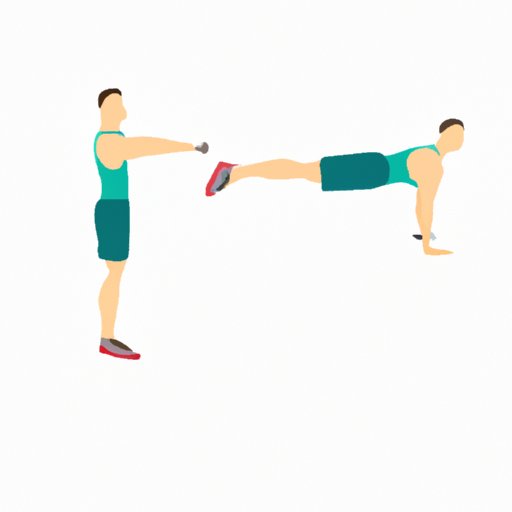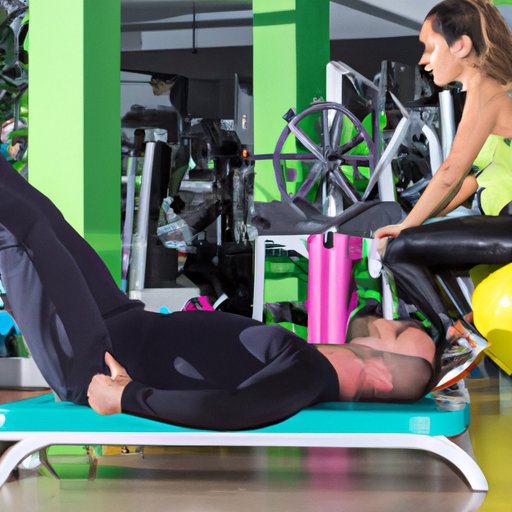
I. Introduction
The dip exercise is a versatile and effective upper body exercise that targets multiple muscle groups. Whether you’re a seasoned gym-goer or just starting out on your fitness journey, adding dips to your workout routine can help you build strength, tone your muscles, and improve your overall physical fitness.
In this article, we’ll take a comprehensive look at the dip exercise and why it’s so beneficial for your fitness routine. From step-by-step instructions on how to perform the exercise to expert tips on maximizing your results, we’ll cover everything you need to know about this versatile exercise.
II. Power Up Your Workouts with the Dip Exercise: A Complete Guide for Beginners
The dip exercise is a compound movement that primarily works your triceps, chest, and shoulders. It’s also a great exercise for building overall upper body strength and stability.
To perform the dip exercise, you’ll need a dip stand or parallel bars. Follow these steps to get started:
- Stand between the parallel bars or dip stand, positioning your hands on each bar.
- Jump up and grip the bars with your hands, palms facing down and fingers wrapping around the bars.
- Straighten your arms and lift your feet off the ground, holding your body up with your arms.
- Lower yourself down by bending your elbows, keeping your torso upright and your feet off the ground.
- When your shoulders reach elbow height, push yourself back up to the starting position by straightening your arms.
- Repeat for the desired number of reps.
When performing dips, it’s important to maintain proper form to avoid injury and get the most out of the exercise. Common mistakes to avoid include:
- Flaring your elbows out too wide, which can strain your shoulders
- Leaning too far forward or backward, which can put undue stress on your lower back
- Rounding your shoulders or neck, which can cause tension and discomfort
To perform dips safely and effectively, you’ll also need the right equipment. A dip stand or parallel bars are the most common tools for the exercise, but you can also use a sturdy chair or bench.
III. The Dip Exercise: How to Build Upper Body Strength and Muscle Tone
The dip exercise is an excellent way to build upper body strength and muscle tone. By engaging the triceps, chest, and shoulders, dips can help you develop a lean, toned upper body.
Building upper body strength is important for a number of reasons. Strong upper body muscles can help you perform everyday tasks more easily, from picking up groceries to lifting heavy objects. They can also improve your posture and body control, which can reduce your risk of injury during exercise or other physical activities.
The dip exercise is particularly effective for building muscle tone because it works multiple muscle groups simultaneously. By performing regular dips, you’ll not only strengthen and tone your triceps, chest, and shoulders, but you’ll also engage your core and back muscles for a comprehensive upper body workout.

IV. Dipping into Fitness: Understanding the Benefits of the Dip Exercise
The benefits of the dip exercise go beyond building upper body strength and muscle tone. Here are a few of the many reasons why dips are such a popular exercise among fitness enthusiasts:
Improved upper body strength and stability
As we mentioned earlier, dips are an excellent way to build upper body strength. By working the triceps, chest, and shoulders, dips can help you develop stronger, more stable upper body muscles that can perform better during your other workouts and physical activities.
Better posture and body control
Strong upper body muscles can also improve your posture and body control, which can help you move more efficiently and with less risk of injury. When your upper body muscles are strong and toned, they can better support your back and spine, leading to improved posture and a reduced risk of pain or discomfort.
Reduced risk of upper body injuries
Weak or strained upper body muscles can make you more susceptible to injury during exercise or other physical activities. By strengthening and toning your upper body muscles with dips, you can reduce your risk of strains, sprains, and other common upper body injuries.
V. Mastering the Dip Exercise: Tips and Tricks for Effective and Safe Training
To get the most out of your dip exercise routine, it’s crucial to maintain proper form and technique. Here are a few tips to keep in mind:
Importance of proper form and technique
Performing dips with proper form is essential for avoiding injury and maximizing the benefits of the exercise. When performing dips, keep your elbows close to your body and your torso upright. Avoid leaning too far forward or backward, which can put undue stress on your lower back. Make sure to engage your core and back muscles to maintain stability throughout the exercise.
Tips for overcoming common challenges when performing the dip exercise
One of the most common challenges when performing dips is maintaining your grip on the parallel bars or dip stand. To help overcome this challenge, consider using grip pads or wraps to improve your grip. You can also adjust your hand position to grip the bars at a comfortable angle.
Guidelines for safe and effective training
As with any exercise, it’s important to start slowly and increase the intensity of your dip workout over time. Aim to perform 10-15 reps per set, and gradually increase the number of sets or reps you can perform as your muscles get stronger. Always warm up before your workout and cool down afterward to help prevent injury.
VI. Why the Dip Exercise Should Be Part of Your Fitness Routine: Insights from Experts
According to fitness experts, incorporating dips into your workout routine can lead to a number of benefits, including:
- Increased upper body strength and stability
- Improved posture and body control
- Reduced risk of upper body injuries
In addition to these benefits, dips are also a great way to challenge your muscles and add variety to your workout routine. Whether you’re a beginner or an experienced gym-goer, dips can help you achieve your fitness goals and build a stronger, healthier body.
VII. Getting More from Your Gym: How to Incorporate the Dip Exercise into Your Workouts
If you’re looking to add dips to your workout routine, here are a few techniques to get you started:
Techniques for adding the dip exercise to a pre-existing workout routine
You can incorporate dips into your workout routine by performing them as a standalone exercise or adding them to a circuit workout. Consider pairing dips with other upper body exercises, such as push-ups or rows, for a comprehensive upper body workout.
Example workout plans featuring the dip exercise
Here are a few example workout plans that utilize the dip exercise:
- The Beginner Plan: Perform 3 sets of 10 dips, taking a break between each set.
- The Intermediate Plan: Perform 4 sets of 15 dips, alternating with 20 push-ups between sets.
- The Advanced Plan: Perform 5 sets of 20 dips, alternating with 30 seconds of mountain climbers between sets.
How to tailor the exercise to meet specific fitness goals
Depending on your specific fitness goals, there are a number of ways to tailor the dip exercise to your needs. For example, if you’re looking to build muscle mass, you can increase the weight or resistance of your dips by using a weighted belt or dipping machine. If you’re looking to improve your endurance, you can increase the number of reps or sets and decrease the rest time between sets.
VIII. Rise Above Your Limits: The Dip Exercise and Its Impact on Physical and Mental Health
In addition to its benefits for physical health, the dip exercise can also have a positive impact on your mental health and wellbeing. Here are a few examples:
Benefits for mental health
Studies have shown that exercise, including dips, can help reduce symptoms of anxiety and depression and improve overall mood. When you perform dips, your body releases endorphins, which are natural mood-boosters that can help you feel happier and more energized.
How the dip exercise can improve overall health and wellbeing
By building strength and muscle tone, the dip exercise can help you achieve overall better health and wellbeing. Strong upper body muscles can improve your mobility, allow you to perform everyday tasks more easily, and reduce your risk of injury. And by boosting your mood and energy levels, regular exercise can help you feel happier, more confident, and more focused throughout the day.
IX. Conclusion
The dip exercise is a versatile and effective upper body exercise that can help you build strength, tone your muscles, and improve your overall physical and mental wellbeing. By incorporating dips into your workout routine and following proper form and technique, you can achieve maximum results and take your fitness to the next level.
To get started, try some of the workout plans and techniques we’ve outlined in this article, and make sure to warm up properly and stretch after your workout. With consistency and dedication, you’ll soon be on your way to a leaner, stronger upper body and a healthier, happier overall lifestyle.




